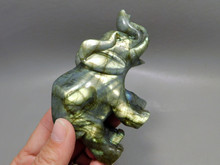Animals, and the human form, are the earliest recorded stone carvings.
Depictions of animals in cave art have been found in more than 100 countries.
From the beginning of recorded history, and probably long before, man has had a relationship with animals. From hunting them for food, to using them for transportation, worshiping them, and befriending them, they are very much a part of our lives.
In Ancient China animals and monsters are almost the only traditional subjects for stone sculpture outside tombs and temples.
In Ancient Africa masks often looked like animals and represented the spirit of the animal in religious ceremonies.
The Ancient Egyptians often combined features from humans and/or various animals. For example, the human head of the pharaoh Khafre is added to the crouching figure of a lion to form the Great Sphinx.
In America all Native American tribes carved small animal fetishes believed to give the holder special characteristics exhibited by that animal. But the Zuni have always had the reputation for being the most skillful at carving them. The Zuni carved animal fetishes as early as 650 AD.
Often times the carvings were anthropomorphic or part man and part animal. The oldest known example of this is the famous Lion Man of Hohlenstein Stadel. This carving, discovered in the Hohlenstein Stadel cave in the Swabian Alps of southwest Germany is believed to be from 38,000 BC. The carving is 11 inches tall and is an ivory sculpture of a Lion Man. It was carved using homemade flint cutting tools. It was discovered in 1939 by archaeologist Robert Wetzel and is now housed in the Ulm Museum in Ulm, Germany.
Two other caves nearby produced highly important ancient carvings believed to be from 33,000 BC., including the oldest known animal carving of a mammoth, as well as some representations of lions, bison, a snow leopard and horses.
Some other examples of known ancient animal carvings include the Swimming Reindeer (c.11,000 BC), a French sculpture of 2 swimming reindeer, carved from a mammoth tusk and now in the British Museum; the silver Iranian statuette known as Kneeling Bull with Vessel (c.3000 BC); the limestone Lioness Demon (c.2900 BC) ornamented with lapis lazuli; the gold figurine known as the Bull of Maikop (c.2500 BC); and Bison Licking Insect Bite, (c.13,000 BC) a carved and engraved fragment of a spear-thrower made of reindeer antler; the piece depicts a member of the now extinct Bison species steppe wisent.
Elk's Head of Huittinen is a Mesolithic moose head figurine of soapstone found in 1903 from Huittinen in the province of Satakunta, Finland. The sculpture is dated between 8,000 and 9,000 years ago. It is placed in the permanent exhibition of National Museum of Finland in Helsinki.
The Alunda moose or the Alunda axe is a Neolithic stone axe (c.2000 BC) was found during the digging of a ditch in Norrlövsta i Alunda parish, Östhammar Municipality, Uppland in 1920. The Alunda moose is a ceremonial ax carved from stone and one side is shaped like a moose head.
An ox and a horned ram were discovered during the construction of a new road in Israel. The figurines, which are carved from limestone and dolomite, are believed to date back between 9,000 and 9,500 years.
The first known animal carving found in America is a mammoth engraved on a mammoth bone. The carving was found in North Vero Beach, Florida by a fossil hunter sometime in 2006 or 2007. It is believed the mammoth carving dates to at least 13,000 years ago when most large Pleistocene animals went extinct in the eastern United States. But the artifact may even be up to 20,000 years old.
To learn more about what animal carvings represents what characteristics click here.
Then explore our great selection of Gemstone Animal Carvings!
 US Dollar
US Dollar
 Australian Dollar
Australian Dollar
 Euro
Euro
 CAD
CAD

